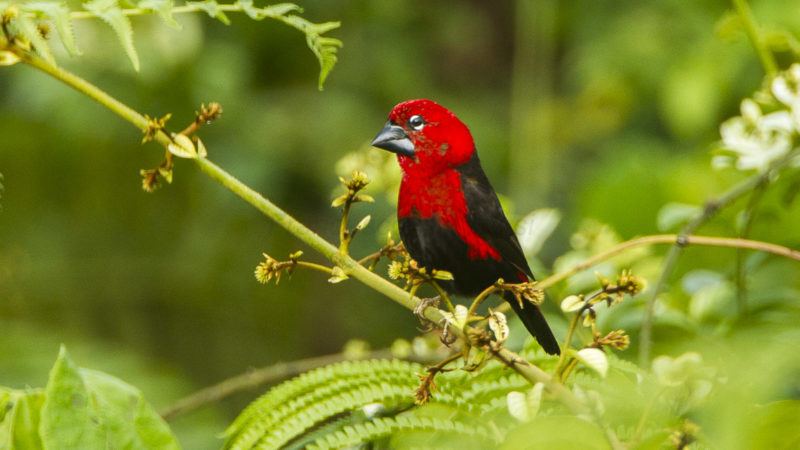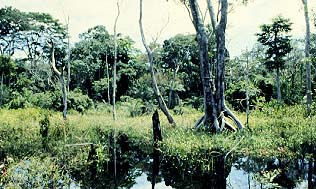A role for migration-linked genes in genomic islands in divergence of a songbird
Published Work | 2014 | Molecular Ecology 23(19), 4757–4769
permalink
Research Project | 2016
Region:
Africa (Cameroon)
The black-bellied seedcracker (Pyrenestes ostrinus) is unusual among birds in exhibiting a non-sex-related polymorphism in bill size and represents one of the few examples of disruptive selection in natural populations. Research on this species focuses on understanding the ecological and evolutionary mechanisms maintaining trophic polymorphisms in birds. This work has included measuring natural selection in natural populations, examining the genetic basis of traits through breeding experiments, and investigating ecological aspects of diet, feeding behavior and competition. Despite increasing evidence of the widespread occurrence of resource polymorphisms in vertebrates, little is known about their genetic basis.
Understanding the genetic basis of a polymorphism when the ecological basis is well understood, as in seedcrackers, has the potential of lending important insights into the evolution of discrete variation and the genetic basis of adaptation. We are currently using molecular genetic approaches to examine the population structure and phylogenetic histories of bill morphs in order to understand how disruptive selection may lead to speciation and we are exploring which genes are involved in generating bill variation.


Related Publications
Published Work | 2014 | Molecular Ecology 23(19), 4757–4769
permalinkPublished Work | 2010 | PLoS ONE 5(11)
permalinkPublished Work | 2009 | Evolution and Development 11(6), 636–646
permalinkPublished Work | 2005 | Molecular Ecology Notes 5(4), 774–776
permalinkPublished Work | 2001 | Genetica 112, 383–398
permalinkPublished Work | Biological Journal of the Linnean Society 71(4), 737–753
permalinkPublished Work | 2000 | Adaptive Genetic Variation in the Wild
permalinkPublished Work | 2000 | Behavioral Ecology 11(3), 345–349
permalinkPublished Work | 1997 | Science 276(5320), 1855–1857
permalinkPublished Work | 1997 | Ibis 139(2), 382–387
permalinkPublished Work | 1996 | Trends in Ecology and Evolution 11(1), 26
permalinkPublished Work | 1996 | Annual Review of Ecology and Systematics 27, 111–133
permalinkPublished Work | 1995 | Trends in Ecology & Evolution 10(9), 366-370
permalinkPublished Work | 1993 | Biodiversity Letters 1(6), 164–167
permalinkPublished Work | 1993 | Nature 363, 618–620
permalinkPublished Work | 1993 | Birds and the African Environment: Proceedings of the Eighth Pan-African Ornithological Congress 268
permalinkPublished Work | 1991 | Oikos 60(1), 76–82
permalinkPublished Work | 1991 | Natural History 100(1), 14-21
download pdf permalinkPublished Work | 1990 | Biological Journal of the Linnean Society 41(4), 381–414
permalinkPublished Work | 1990 | Ecology 71(4), 1246–1257
permalinkPublished Work | 1990 | Evolution 44(4), 832–842
permalinkPublished Work | 1990 | The Auk 107(1), 153–160
permalinkPublished Work | 1989 | Journal of Field Ornithology 60(1), 56–59
permalinkPublished Work | 1988 | The Journal of Parasitology 74(6), 1009-1013
permalinkPublished Work | 1987 | Nature 329, 717-719
permalink